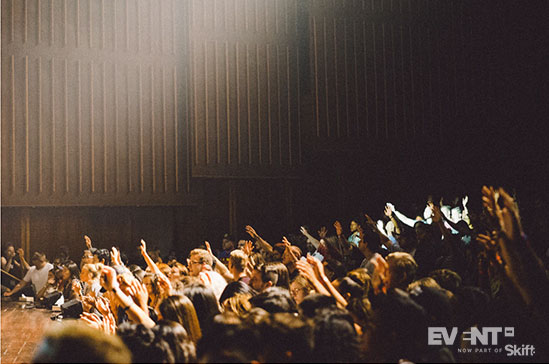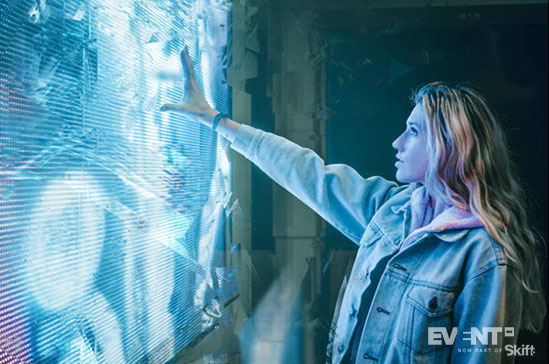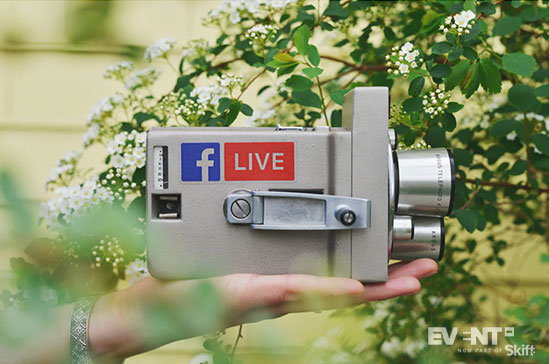Skift Take
Interactive sessions are the future, be they roundtable, creative Q&A, or other novel formats. Learn how they can bring a breath of fresh air to your event and successfully engage attendees.
When I first started out organising conferences they weren’t the most sophisticated events. One person standing in front of a big screen. They would have a Powerpoint deck projected on the screen and we’d work through a dozen speakers a day.
As we’ve matured and our audience has changed, we’ve tried out a variety of different formats at varying degrees of success. One of the most successful has been the roundtable.
These aren’t necessarily revolutionary formats. You might have something similar as part of an event you organise. But as they are becoming more important, we think it’s important to revisit some of the most common formats and the best practices for executing them.
In this post, I wanted to share a few insights I’ve gained organising roundtables and other interactive sessions.
Roundtables
What do we mean by a roundtable? It’s a gathering of about a dozen interested people, often with similar interprets or job titles. They last about an hour and a half and have been successful editorially but also commercially, with companies paying to sponsor or host the roundtable.
Here are four things we learned in our early days doing roundtables that can make or break the event experience for your attendees:
Clear Focus
Our best roundtables are always those with the clearest focus. There are complex, messy aspects of every profession. The more precise the topic is, the more successful it will be.
We often like to organize themes around industries or specific specialities. These are nicely self-contained. While participants benefit from the knowledge shared within sessions, the networking component is increasingly important. They take a huge amount from meeting people likeminded professionals.

Comprehensive Agenda
Having a clear theme or topic will fuel productive conversation at your roundtable, but facilitators should be well-versed enough for a deep discussion, especially important if your group takes a bit of time to warm up.
I’ve moderated some roundtables where we’ve only had a few discussions points. We breezed through them while participants were getting ‘warmed-up’ and had to ad-lib the rest of the session.
This doesn’t mean you’ll have a bad roundtable, but the more preparation you can do, the less stressful it will be for the moderator.
Strong Moderator
A key role in any roundtable is the moderator. This is the person chairing and often leading the discussion. This can be a tricky person to find especially if you’re working with sponsors on a roundtable.
This person has to be articulate, confident and knowledgeable about the topics discussed. Instinctively, we turned to our conference speakers to be moderators. This had varying degrees of success.
They were knowledgeable, but that didn’t always lead to them being good roundtable moderators.
Being a good conference speaker requires a clarity and certainty of thought. This doesn’t always match well with the collaborative and democratic nature of a roundtable.
The last thing you want is a moderator who dominates the discussion. Their job is hard. They have to:
- Tease out themes and patterns in the discussion.
- Involve less confident participants.
- Deter over zealous members of the roundtable and keep the discussion moving in a relaxed but purposeful way.
It’s a tough job. if you find the right person do all you can to keep working with them.
Selective Invites
When we were starting out, our biggest concern with roundtables was getting bums on seats. We wanted as many people to attend as possible so our sponsors got the most value for their money.
Early on, we learnt with roundtables that quality always trumps quantity. It was at this point we got a lot more selective about who we invited or encouraged to attend roundtables. We knew who should and shouldn’t attend. The clearer idea helped us create an experience that worked for all the participants.

Interactive Q&A Sessions
According to The Atlantic, the concept of ‘Ask Me Anything’ started in 1992 with the debut of a book called Ask Me Anything: A Sex Therapist Answers the Most Important Questions for the 90’s. KnowYourMeme says there was a mid-’90s AOL chatroom called, “Ask Me Anything” in the romance category. (Though it had disappeared by 1999, when the Internet Archive began capturing data on aol.com.)
The concept was then adopted by several popular internet outlets, but found its popularity when forum-style website Reddit started a thread where users could ask founders of the site or subculture celebrities any questions they wanted. AMA® and Ask Me Anything® are, in fact, trademarks owned by Reddit.
Long story short, President Obama answered questions on the site and a myriad of other celebrities followed. There is a book about it if you want to read more.
So how can you execute an interactive Q&A of this type?
The format needn’t be complicated. Let anyone ask anything – it’s as simple as that.
Of course, not all questions need to be answered. Allow upvoting and comments so the people being asked can filter by relevance to the audience or dive further into topics by responding to comments in the thread.
Questions can be really trivial or very challenging. In a Reddit AMA, Sir David Attenborough got asked about his most upsetting career moment, which led to a very heartfelt reply.
Barack Obama was asked about the White House beer recipe :-).
This mix of silliness and meaning is what makes these sessions widely popular, but they also carry a lot of potential to deliver targeted, relevant content. With access to the experts, attendees can get targeted advice on their specific context, as opposed to a general address which has its evident limits.
As our latest report on engagement shows, events have evolved. Attendees want interaction, and event technology offering engagement is booming.
Not all that glitters is gold though. While putting a personality, celebrity or performer in touch with your audience sounds like the ultimate idea, you really need to consider carefully whether this is the right move for your event.
So let’s have a look at 9 tips to make sure your interactive Q&A session is spotless:
Carefully Pick Your Speaker
I can talk about #eventtech for hours. If you’ve met me around the world, you know how annoying I can be talking and talking about #eventtech. I never stop. See that’s my passion. I breathe it every day, 12 hours a day.
If your speaker is not confident enough with the subject, you may want to reconsider. You need a very high degree of confidence with the subject to perform.
Otherwise, speakers may try to divert the conversation at times, and attendees might bring the conversation back to pain points which can sometimes represent very difficult topics to elaborate in quick answers.
Make sure your speaker is comfortable with the session, make sure that they are 100% on board and committed to make the most out of the experience.

Have a Good Mod
Moderators or MCs have a key role in the success of an interactive session. Their role is slightly different from moderating a panel or roundtable: they need to be more incisive, tech savvy and aware of the audience.
These five tasks are instrumental in securing success:
- Explaining how the session was going to unfold
- Stimulating questions on the showfloor
- Selecting the best questions on the app
- Moderating inappropriate questions out of the public display
- Keeping track of the time
If not taken care of, they will have a negative impact on the success of the session.
Use Technology
Interactive sessions are the brainchild of the internet and tech evolution. Using technology is key.
If you run events, you know that attendees are reluctant to ask questions at the end of regular sessions. This is not necessarily because they don’t want to, but because they are scared to speak in public. Technology is a fantastic solution to this problem. Attendees can use apps or audience response systems to ask questions live. Other attendees can vote up questions they want answered.
Tech can also help to visualize questions on the main screen, which helps those in need of visual aids during sessions. Although attendees may like the novelty of the session, they still want some form of structure. This is one of the key reasons why formats like the unconference struggled to become mainstream. The complete lack of structure can confuse attendees.

Prepare
So you have your speaker ready for an amazing interactive session, all the attendees seated and excited, yet no questions are coming in. This is a quite likely scenario. We love to think attendees share the same commitment and interest in sessions, but realistically they might only have decided to attend a few minutes before.
You need to have some questions ready, in accordance with your speaker, that can serve as an ice breaker or safety net if few questions come in during the session.
These can serve the purpose of explaining how the session is going to work. Also have some prepared on the tech platform you are going to use. It will show your attendees the benefit of using the app to ask questions.
Promote The Session Adequately
Try to make sure that attendees know well in advance that you are going to run a session dedicated to Q&A and that they can ask whatever they want. Using your website and most of all social media to communicate what you are trying to do is instrumental to the end result.
This gives attendees the chance to prepare as well. It also reduces that ‘Where am I?’ factor some audiences may experience when confronted with a different session format.
Additionally, it will give your speaker enough confidence to perform and not think they are going against a public execution in front of hundreds of people.
Sync Your Social
Social media is a key element of a good interactive Q&A session. It is probably the best channel to promote it. Social users are more confident with the concept of interactive and they may serve as echo chambers to your innovative attempt.
Social is also a key part of the actual session. Having someone from your team to summarize the answers you give on social media will help to digest what is being discussed and expand reach, involving remote audiences in the conversation. If you followed point #3 they will be able to ask questions via the app.
Your live (moderated) social wall can display the the best bits of the action for others at the event and attract attendees from other areas of the venue.
Stream It!
Crowdstreaming is a powerful tool for extending reach and access to an even bigger audience. Invite attendees to stream the session live. Set up a stream yourself if they are not ready.
This is a great way to turbocharge remote attendance. The benefits are indisputable. You get more questions in, which is a very good thing. You get more engaged attendees online willing to learn more about your event and very likely attending next year. This is quickly becoming a given for most events.
interactive sessions are perfect for remote audiences. In fact they were born this way. Do not miss out on the opportunity. As always, the official stream needs to be of quality and you need to have someone dedicated to look after it.

Get the Speaker on the Floor
As the first questions come in, speakers quickly realize the stage is incongruent with the type of session being had. Invite speakers to jump off stage to mingle with the crowd and be closer to them.
Done right, interactive Q&A sessions are very personal. The speaker should walk around the audience. They should be close to who is asking the question. The idea is to break down the barriers between the audience and the speaker. Break through the aura celebrities have and make them accessible to our audience.
The speaker on stage is the legacy of how we used to do things 30, 40, 50 years ago. Connecting your speaker to the audience is actually a very good idea, regardless of what type of session you are running.
Embrace Risk
Interactive Q&A sessions are not for the risk averse. In the same way that event professionals dreaded social media in its early days for the fear of being talked about negatively, an interactive approach can be perceived as risky. This is partially true. You don’t know what the audience will ask, you don’t know if questions will be submitted, you don’t know how the speaker is going to react, you don’t know whether the end result will be useful and universally valuable for your audience.
But high risk = high return. If your audience appreciates and responds well to the format, the rewards can be considerable. We’re talking about unfettered access to a popular or influential speaker that offers people a chance to get unpublished insights into relatable problems. This is the stuff of memorable sessions.
IN CONCLUSION
Roundtables and interactive sessions are potentially very disruptive for the industry. Lots of good can come out of them if handled correctly.
If you are willing to see one in action, come see one of my talks. It will be a great opportunity to put me and what I just shared to the test.
Have you tried roundtables or interactive sessions at your events? Can you share more tips?





